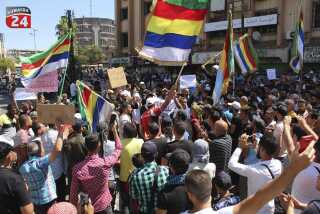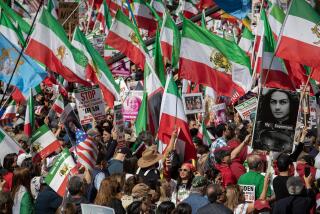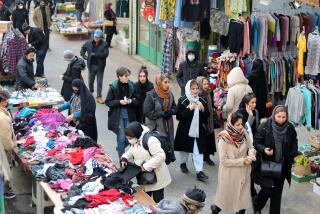Iran protests over soaring gas prices turn violent
TEHRAN — Demonstrations over the Iranian government’s sudden decision to raise basic gasoline prices by as much as 50% took a violent turn Saturday when security forces clashed with people in several cities across Iran.
Thousands took to the streets for a second day to show heightened frustration over what they say is the country’s crumbling economy.
The unrest stemmed from Iranian President Hassan Rouhani’s announcement Friday of reductions in government gasoline subsidies and the price increase in order to set aside funds to help the nation’s poor. Iranians already hit hard by President Trump’s reimposition of economic sanctions last year suddenly saw the price of subsidized gasoline jump 50% and unsubsidized gasoline increase three times from what it was a day earlier.
On Friday, peaceful protests took place across Iran, spreading overnight to major cities including Tehran, Mashhad and Shiraz. Demonstrations were held in at least 40 cities and towns on Saturday, some of them devolving into violence.
Videos circulated on social media showed buildings ablaze and police opening fire on protesters in the streets.
In the southeast city of Sirjan, at least one person was killed and several others wounded, government officials confirmed. In Tabriz, videos show riot police beating demonstrators. In snowy Tehran, drivers on congested roads switched off their engines and started shouting chants against President Hassan Rouhani. In at least one instance, demonstrators were heard chanting “death to the dictator” — a reference to Supreme Leader Ayatollah Ali Khamenei.
The increase means that drivers will now pay 15,000 rials, or $0.127, per liter of gas for their first 60 liters each month — a 50% increase. Motorists will pay 30,000 rials or $0.254 for each additional liter each month. The day before the subsidies were reduced, the price for a liter of gasoline stood at 10,000 rials, and drivers were allowed to purchase up to 250 liters at that price.
Although the price of gasoline in Iran still remains among the cheapest in the world and is one of the most heavily subsidized, the devaluation of Iran’s rial coupled with a rise in the inflation rate — which currently hovers above 40% — has already resulted in skyrocketing prices of food, medicine and other basic commodities. As a result, people from all walks of life are struggling to make ends meet.
To curb the flow of information, the country’s internet was drastically slowed down Saturday, and the largest mobile network operator fell offline, according to NetBlocks, a civil society group that works on issues concerning digital security.
Religious clerics and officials, in anticipation of a backlash, unsuccessfully tried to ease people’s concern Friday by saying that the decision to increase the price of gasoline was adopted after consulting with economists. Mohammad Bagher, Iran’s vice president for budget affairs, said the money raised from the price increase would help provide additional subsidies for 60 million Iranians. “The first payments will be handled in about 10 days,” he said in an announcement Friday. The population of Iran is estimated to be about 80 million.
A similar situation unfolded in 2007, when then-President Mahmoud Ahmadinejad imposed a policy of fuel rationing. Protests erupted across major cities, and buildings were set ablaze.
Anger over Rouhani’s announcement was compounded by the fact that just a week before he had boasted that the Islamic Republic had found a large oil field in southwest Iran.
Iran’s middle class and poor have been affected most by the Trump administration’s “maximum pressure” policy, which began after the U.S. withdrew last year from the 2015 nuclear accord, experts said in recent months. Since then, Washington has intensified its campaign of economic sanctions, targeting the country’s oil, energy, banking and metals industries.
Oil exports have fallen 80% since the sanctions were put into place, and the International Monetary Fund predicts that Iran’s economy will shrink by 6% this year.
Special correspondent Mostaghim reported from Tehran and Times staff writer Etehad from Los Angeles.
More to Read
Sign up for Essential California
The most important California stories and recommendations in your inbox every morning.
You may occasionally receive promotional content from the Los Angeles Times.











